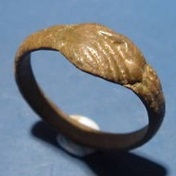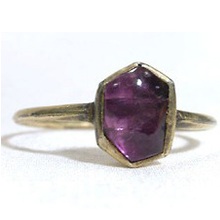The History of Engagement Rings
The history of engagement rings is quite interesting. While this website was designed to educate you on the different type of engagement rings we decided it would be fun to also include their history. Youíll find that some of the common traditions today relate back to ancient civilizations in the past. This short historical guide was written based off research and information from multiple sources, including Wikipedia & Readerís Digest. Please contact us if you see any incorrect information or wish to add something.

Itís impossible to determine who actual came up with the concept of an engagement. The Archduke Maximilian of Austria was the first person documented as using a diamond ring to signify an engagement. The lucky first woman to receive that ring was the Mary of Burgundy, in a Vienna court in 1477. However, itís widely believed that cavemen used cords made of braided grass as symbol of engagement. To be more precise caveman actually tied these cords around the womanís ankle, wrist and waist to control her spirit; obviously these cavemen never had to deal with modern women!
Ancient Egyptians used engagement bands back in Ancient Egypt. These bands symbolized a never ending cycle and the space in the middle of them was a gateway. The Ancient Egyptians are actually the people who designated the ring finger, or the forth finger on your left hand. They believe the fourth finger (ring finger) was directly connected to the heard via a vein.
 During the Roman times they actual used what was a called a betrothal ring which was their version of an engagement ring. Along with the betrothal ring Roman men also gave the women a small key. Many historians believe this key stood for the unlocking of wealth their marriage would bring, unlike the common belief that it was the key to the husbandís heart. Romans believed that the betrothal ring stood for ownership instead of love or marriage. It was believed that the ring in Roman times was the way a male would claim his wife. Roman brides in the second century were given 2 rings, one which was made of gold and one that was made of iron. The iron ring was to be worn at home while the gold ring was made for public display.
During the Roman times they actual used what was a called a betrothal ring which was their version of an engagement ring. Along with the betrothal ring Roman men also gave the women a small key. Many historians believe this key stood for the unlocking of wealth their marriage would bring, unlike the common belief that it was the key to the husbandís heart. Romans believed that the betrothal ring stood for ownership instead of love or marriage. It was believed that the ring in Roman times was the way a male would claim his wife. Roman brides in the second century were given 2 rings, one which was made of gold and one that was made of iron. The iron ring was to be worn at home while the gold ring was made for public display.
The first notable history of engagement rings being directly tied to marriage was in 1215 by Pope Innocent III. The Pope was the one who started the waiting period between the promise of marriage and the actual act of getting married. The ring was a way to identify the couples promise and devotion to each other during that period of time. At that time anyone seen wearing an engagement ring was often wealthy and it became a social symbol for those with money and power.
 Prior to the 20th century many other different types of betrothal gives were common. Towards the end of the 19th century future brides would get a sewing thimble instead of an engagement ring. This was common among the lower and middle class people and some religious groups that were against jewelry. It was actually around the 19th century when diamond engagement rings became common due to available diamond mines in the 1870s which helped lower the costs. Men started wearing wedding rings all the time during World War II to help a solider remind them of their family and wife back home.
Prior to the 20th century many other different types of betrothal gives were common. Towards the end of the 19th century future brides would get a sewing thimble instead of an engagement ring. This was common among the lower and middle class people and some religious groups that were against jewelry. It was actually around the 19th century when diamond engagement rings became common due to available diamond mines in the 1870s which helped lower the costs. Men started wearing wedding rings all the time during World War II to help a solider remind them of their family and wife back home.
Itís believed that over 82% of the women in the United States are offered an engagement ring when proposed to. In the 21st century, Western civilization helped promote and increase the common expectation that a woman would wear her engagement ring until marriage to provide proof and show their commitment to their future marriage. Itís amazing how weíve come from cavemen who used engagement bands to control a womenís spirit to the 21st century were women wear an engagement ring to signify their future commitment to their fiancťe.
